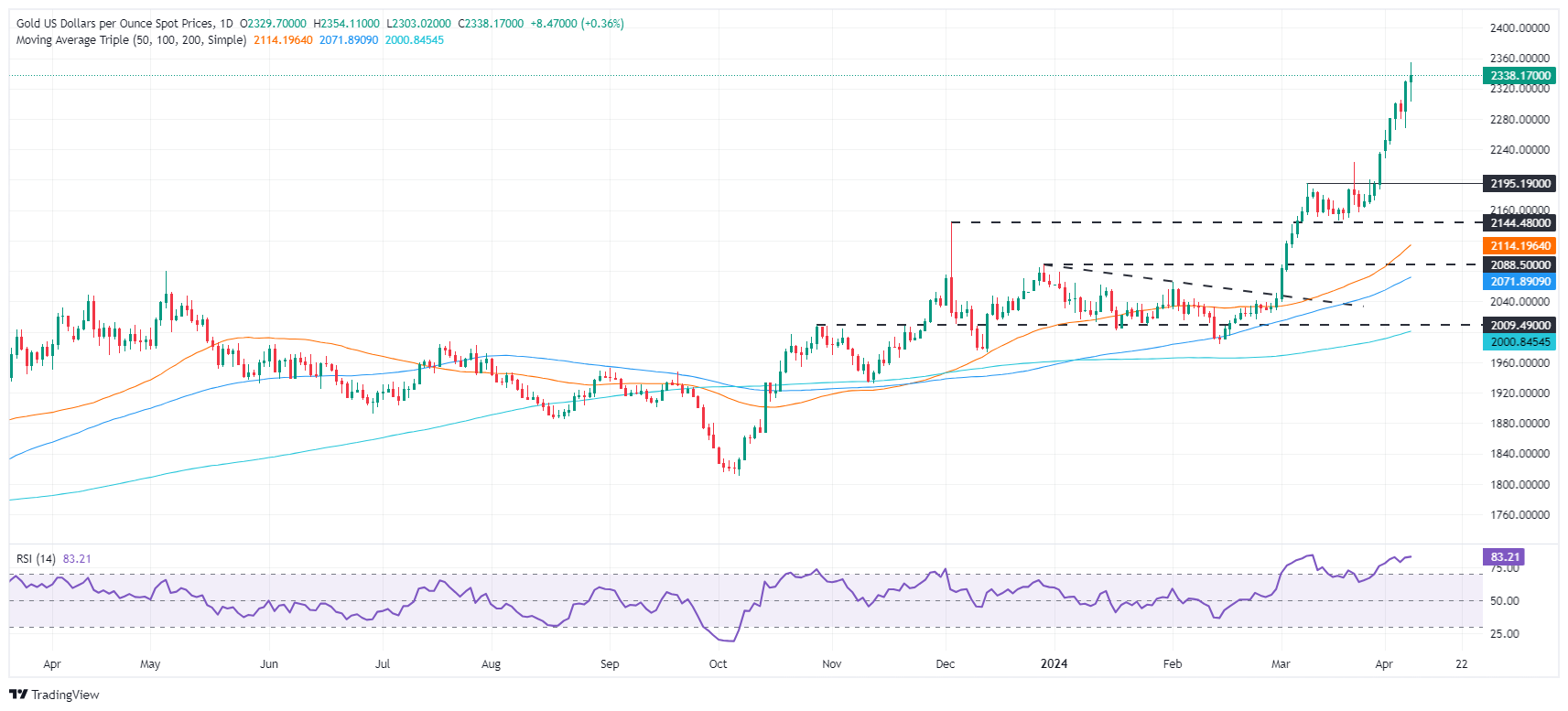- Gold's rise to $2,354 was tempered by developments in Fed rate cut expectations and the resilience of the US employment report.
- Citi analysts expect gold to continue rising, with forecasts of up to $2,500 in more bullish scenarios.
- The market's recalibration on the Federal Reserve's interest rate policy reflects a balanced outlook.
The price of Gold fell on Monday after reaching all-time highs of $2,354 during the middle of the American session. The yellow metal's advance continues amid a rise in US Treasury yields and a lower probability of further rate cuts by the Federal Reserve (Fed). A stronger-than-expected US Nonfarm Payrolls report last Friday was no excuse for the metal's lackluster advance. At the time of writing, the XAU/USD pair is trading at $2.327, representing gains of 0.30%.
Expectations of rate cuts by the Fed and purchases by central banks remain the main drivers of Gold's rally. Meanwhile, Wall Street banks began to revise their forecasts upwards. According to sources cited by Marketwatch, Citi analysts updated their three-month forecast to $2,400, and their most bullish scenario places the precious metal at $2,500.
The latest jobs report showed the economy added more jobs than expected, while the unemployment rate fell. Meanwhile, Fed rate cut expectations are being adjusted, with investors speculating that the U.S. central bank will begin cutting rates in July instead of June. The odds of a rate cut in June are 50%, while for July they are 69%.
Meanwhile, Fed officials remain optimistic about a rate cut but insist on the need for patience.
Daily Market Summary: Gold Trims Gains Amid Rising US Yields
- The US Department of Labor announces that Non-Farm Payrolls increased by 303,000 in March, above the 200,000 expected and the previous 270,000.
- The unemployment rate fell slightly from 3.9% to 3.8%, and average hourly earnings met consensus estimates. Average hourly earnings increased 0.3% month-over-month, up from 0.2% previously. In the twelve months to March, profits rose 4.1%, as expected, versus 4.3%.
- Geopolitical risks loom after Israel's attack on Iran's embassy in Syria. Iran vowed to retaliate against Israel after the deaths of seven officials. A new rally could put upward pressure on gold prices, with traders targeting $2,350.
- The World Gold Pool reveals that the People's Bank of China was the largest buyer of the yellow metal, increasing its reserves by 12 tons to 2,257 tons.
- Investors are focused on the upcoming US Consumer Price Index (CPI) data for March, which will be released on Wednesday. Inflation data will provide additional information on when the Federal Reserve may begin lowering its interest rates. Strong price pressure could dampen expectations of rate cuts in June, while softer inflation figures could fuel speculation about rate cuts.
Technical analysis: Gold continues to rise after falling to $2,303

Gold's rise will continue, with buyers gaining momentum. The Relative Strength Index (RSI), although in overbought conditions beyond the 70.00 level, is pointing north. Typically, when an asset is in a strong uptrend, the reading of 80 is considered the extreme of overbought.
Previously, Gold fell to a low of $2,303 before resuming its rise. That said, the first resistance would be the all-time high of $2,354. Once surpassed, the next stop is at $2,400, followed by $2,500.
On the other hand, the first support level would be $2,300. Breaking this last level would expose $2,250, followed by $2,200.
Inflation FAQ
Inflation measures the rise in prices of a representative basket of goods and services. General inflation is usually expressed as a monthly and annual percentage change. Core inflation excludes more volatile items, such as food and fuel, which can fluctuate due to geopolitical and seasonal factors. Core inflation is the figure economists focus on and is the target level of central banks, which are mandated to keep inflation at a manageable level, typically around 2%.
The Consumer Price Index (CPI) measures the variation in prices of a basket of goods and services over a period of time. It is usually expressed as a percentage of monthly and annual variation. Core CPI is the target of central banks as it excludes food and fuel volatility. When the underlying CPI exceeds 2%, interest rates usually rise, and vice versa when it falls below 2%. Since higher interest rates are positive for a currency, higher inflation usually translates into a stronger currency. The opposite occurs when inflation falls.
Although it may seem counterintuitive, high inflation in a country drives up the value of its currency and vice versa in the case of lower inflation. This is because the central bank typically raises interest rates to combat higher inflation, attracting more inflows of global capital from investors looking for a lucrative place to park their money.
Gold was once the go-to asset for investors during times of high inflation because it preserved its value, and while investors often continue to purchase gold for its safe haven properties during times of extreme market turmoil, this is not the case. most of the time. This is because when inflation is high, central banks raise interest rates to combat it. Higher interest rates are negative for Gold because they increase the opportunity cost of holding Gold versus an interest-bearing asset or placing money in a cash deposit account. On the contrary, lower inflation tends to be positive for Gold, as it reduces interest rates, making the shiny metal a more viable investment alternative.
Source: Fx Street
I am Joshua Winder, a senior-level journalist and editor at World Stock Market. I specialize in covering news related to the stock market and economic trends. With more than 8 years of experience in this field, I have become an expert in financial reporting.







